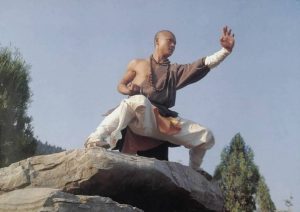Stances:
Wu Ji Stance
Bow Stance
Forward Bow Stance
Empty Step
Wu Ji Stance:
Knees unlocked and comfortably bent
Legs should be hip-width apart (shift all weight to one leg, touch heel of empty leg forward and then sweep around to side. Where foot lands with zero weight is proper hip-width for you). Imagine you are standing on rails.
Pelvis is relaxed and leveled ( see rule #4)
Shoulders square with hips (see rule #5)
Arms hang or hold a ball
Head pulled heaven-ward (see rule #7)
Bow Stance:
From Wu Ji stance, shift weight to one leg (becomes heavy) and the toes of light leg turns out 45 degrees. The heel of light leg remains in place – you are still standing on rails.
Now slowly shift weight onto light leg and hips and shoulders turn in the direction of your pointed toes.
Forward Bow Stance:
From Bow stance, shift weight fully to turned leg and bring back leg straight forward. Shift your weight forward.
Alternatively, you can step back into Bow Stance.
From Wuji stance, shift all of your weight to one leg.
Step light leg backwards with toes pointing out 45 degrees.
You should still be standing on rails – back leg should not be directly behind front leg.
Forward Bow and Bow stance should feel very much the same – they just have different directions from starting point.
Empty Step
One leg becomes fully heavy and they other touches down without any weight (empty)
There is a forward empty toe step like in White Crane Spreads it Wings, and empty heel step (usually with toes pointing 45 degrees to side) like in Play the Pipa and there is an empty toe to the side – “cat stance”.
There is also an empty step called a “T-step” where the feet are perpendicular. (heavy leg is top of “T” and light leg is the length of the “T”) This is often used as a transition step between movements or in Tai Chi Walking.
